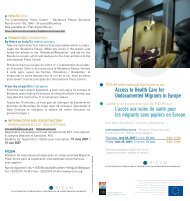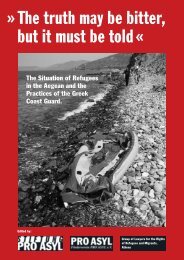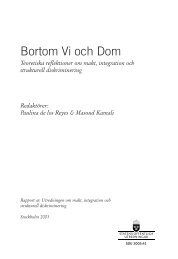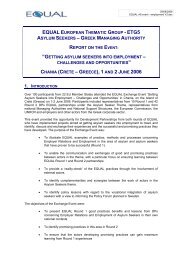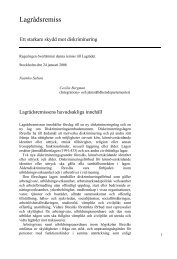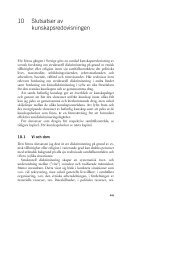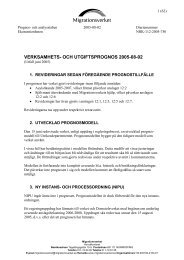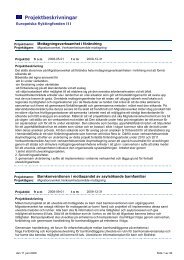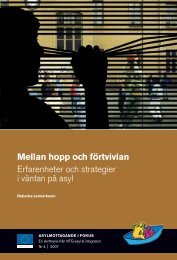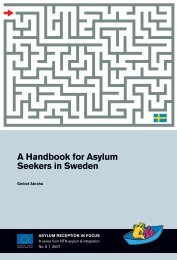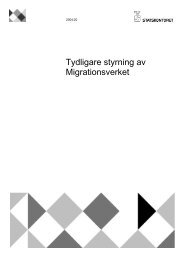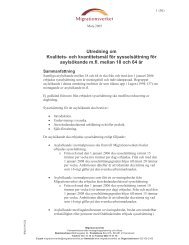and the Construction of Vulnerability - Child Trafficking
and the Construction of Vulnerability - Child Trafficking
and the Construction of Vulnerability - Child Trafficking
Create successful ePaper yourself
Turn your PDF publications into a flip-book with our unique Google optimized e-Paper software.
dren, seeing it as opening opportunities for a better future to <strong>the</strong>m”. 43<br />
When children are orphaned, or <strong>the</strong>ir parent(s) fall sick, <strong>the</strong>y <strong>of</strong>ten find <strong>the</strong>mselves<br />
in a situation whereby <strong>the</strong>y need to earn money to support <strong>the</strong>mselves, sometimes<br />
also <strong>the</strong>ir dependent younger siblings or ill parents. As <strong>the</strong> literature on AIDS<br />
orphans shows, 44 this can be a trigger for independent labour migration. iv Similarly,<br />
when persons under <strong>the</strong> age <strong>of</strong> 18 have children <strong>of</strong> <strong>the</strong>ir own, <strong>the</strong>y need to support<br />
<strong>the</strong>m economically. If this is difficult or impossible to achieve in <strong>the</strong>ir home<br />
village or town, or in <strong>the</strong>ir home country, labour migration may appear to be <strong>the</strong><br />
best option.<br />
There is a good deal <strong>of</strong> research evidence to suggest that independent child labour<br />
migrants are vulnerable to exploitation <strong>and</strong> abuse at <strong>the</strong> point <strong>of</strong> destination (see<br />
Section 6 below). However, employment relations <strong>and</strong> working conditions range<br />
along a continuum, <strong>and</strong> even when we focus on <strong>the</strong> poorest <strong>and</strong> most exploitative<br />
end <strong>of</strong> <strong>the</strong> spectrum, <strong>the</strong>re are still gradations in terms <strong>of</strong> just how dangerous,<br />
exploitative <strong>and</strong> poorly paid work is. If we also remember that when children<br />
migrate, <strong>the</strong>y are not necessarily leaving an environment within which <strong>the</strong>ir rights<br />
are guaranteed, <strong>the</strong>n it is easier to underst<strong>and</strong> that labour migration (even into working<br />
conditions that are far from ideal) can be viewed by <strong>the</strong> children concerned as<br />
having positive, as well as negative, outcomes.<br />
For instance, research in Tempane Natinaga, Ghana, found that children who<br />
remained in <strong>the</strong>ir place <strong>of</strong> birth working for <strong>the</strong>ir own families were <strong>of</strong>ten expected<br />
to undertake extensive <strong>and</strong> heavy labour without pay, <strong>and</strong> enjoyed few <strong>of</strong> <strong>the</strong> basic<br />
rights set out in <strong>the</strong> CRC. It also found that children who migrated to work were<br />
<strong>of</strong>ten positive about <strong>the</strong>ir experiences. Migrant work afforded <strong>the</strong>m “<strong>the</strong> opportunity<br />
to develop important relationships or skills, <strong>and</strong> to earn an income which <strong>the</strong>y<br />
had significant control over <strong>and</strong> which allowed <strong>the</strong>m to buy <strong>the</strong> things necessary for<br />
<strong>the</strong>ir progression into adulthood”. 45 The same point emerges from interviews with<br />
child labour migrants in several African <strong>and</strong> South Asian countries. 46 These interviews<br />
show that such children are <strong>of</strong>ten vulnerable to a range <strong>of</strong> different forms <strong>of</strong><br />
abuse <strong>and</strong> exploitation. They also demonstrate that many child labour migrants are<br />
actively pursuing <strong>the</strong>ir own goals <strong>and</strong> dreams <strong>and</strong> evaluate <strong>the</strong> experience <strong>of</strong> migration<br />
positively. This is illustrated by <strong>the</strong> following extract from an interview with a<br />
17 year old who had migrated from Karnakata to Bangalore at <strong>the</strong> age <strong>of</strong> 13:<br />
“The advantages <strong>of</strong> life as a migrant include good food, life in <strong>the</strong> city, increased<br />
income, business contacts <strong>and</strong> <strong>the</strong> opportunity to search for alternative options in<br />
<strong>the</strong> future.There are no disadvantages.” 47<br />
If, instead <strong>of</strong> imagining that independent child migration is always a desperate last<br />
resort, we think about <strong>the</strong> positive value that many children, <strong>the</strong>ir parents <strong>and</strong> <strong>the</strong>ir<br />
wider community attach to opportunities to migrate, it becomes easier to explain<br />
43. Whitehead <strong>and</strong> Hashim, 2005, p. 26; Caouette, 2001; Save <strong>the</strong> <strong>Child</strong>ren UK, 2006<br />
44. Ansell <strong>and</strong> Young, 2003a <strong>and</strong> b, 2004; Evans, 2005<br />
45. Hashim, 2003, p. 12; see also Busza, Caste <strong>and</strong> Diarra, 2004<br />
46. Anarfi et al, 2006<br />
47. Anarfi et al, 2006, p. 24<br />
24<br />
<strong>Child</strong> Migration <strong>and</strong> <strong>the</strong> <strong>Construction</strong> <strong>of</strong> <strong>Vulnerability</strong>




